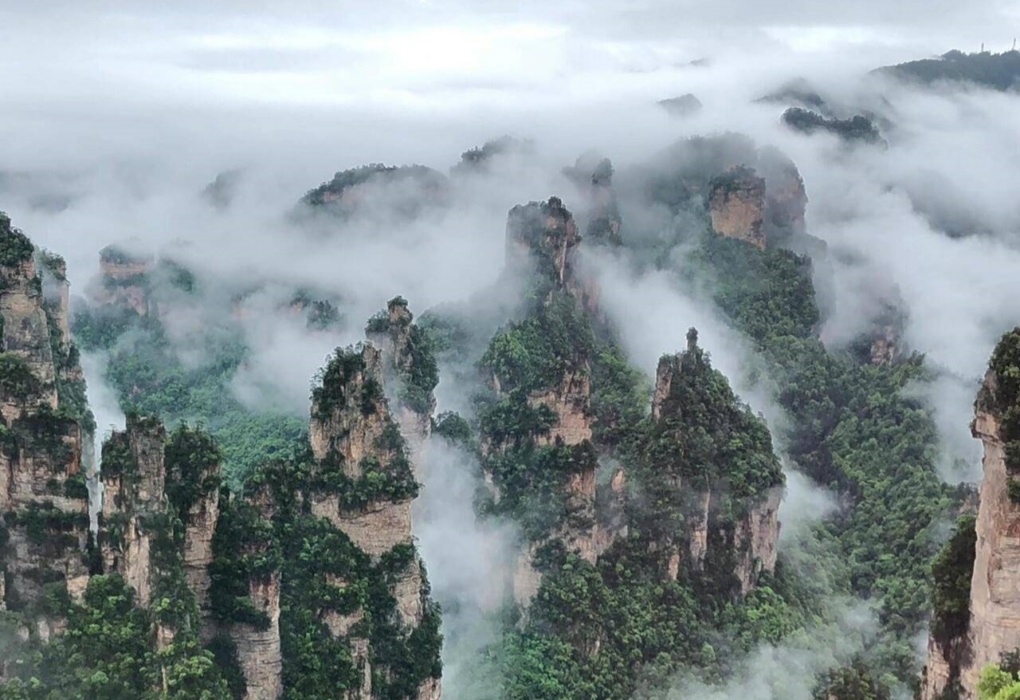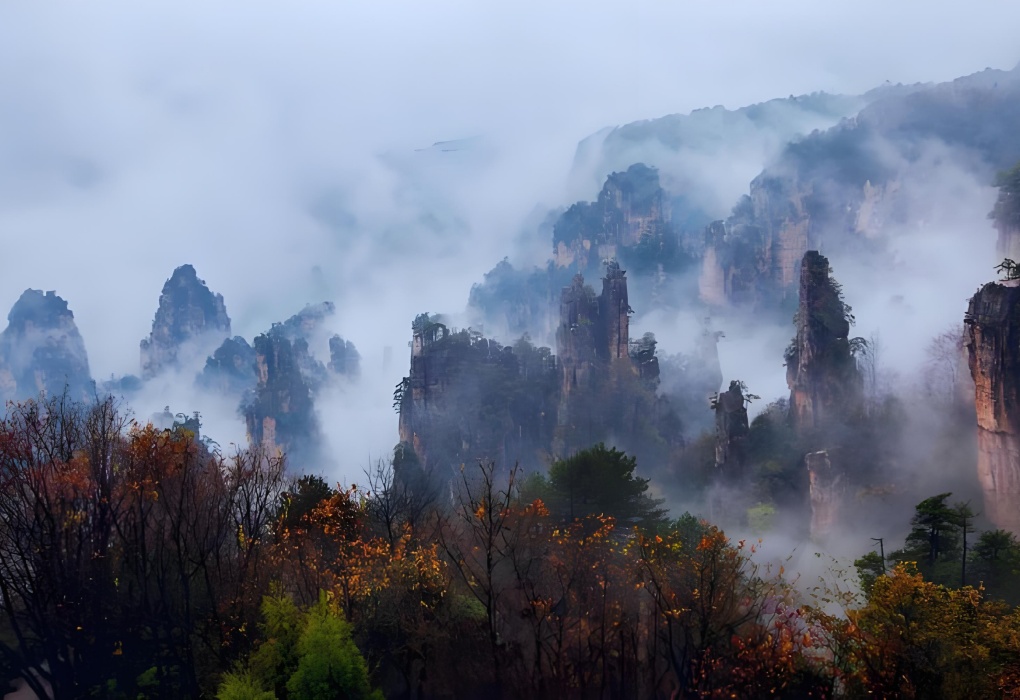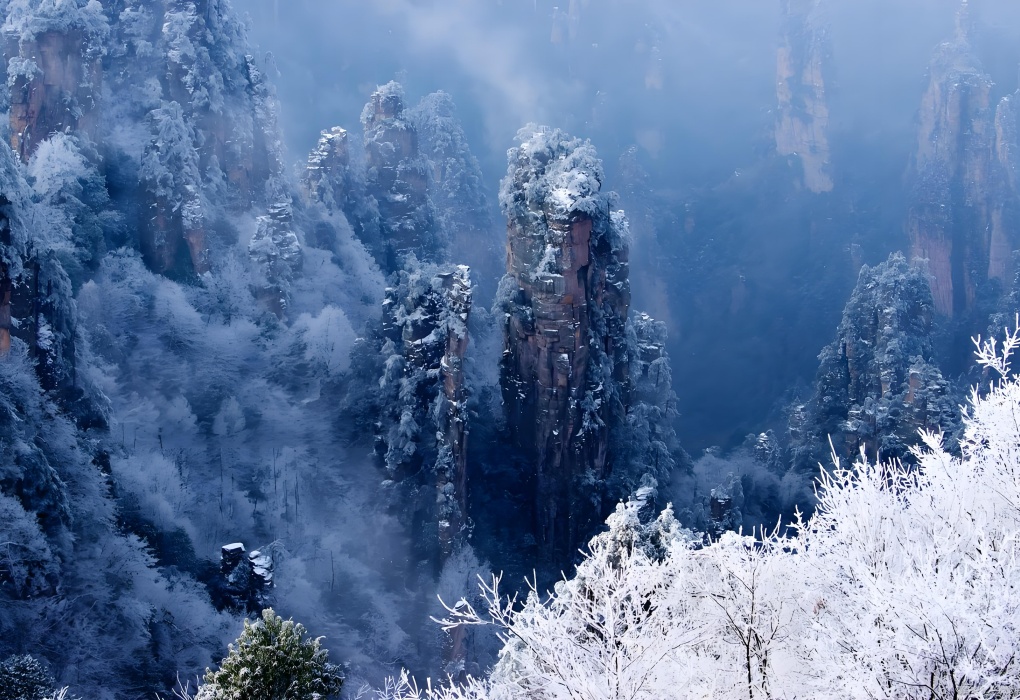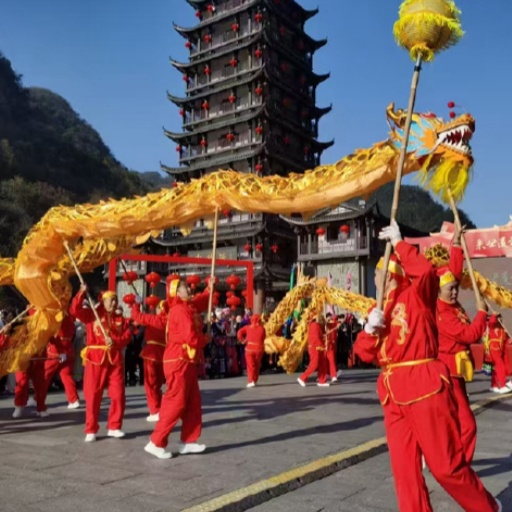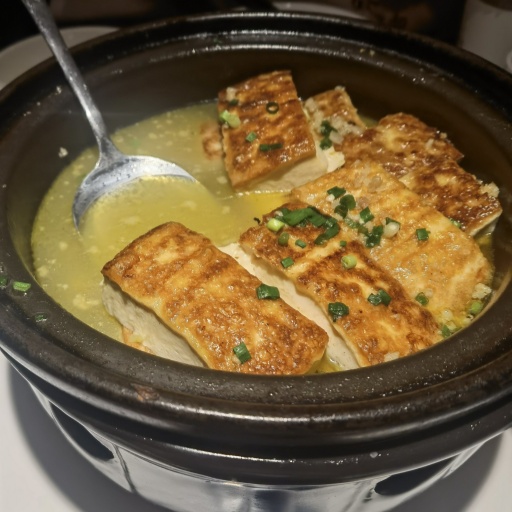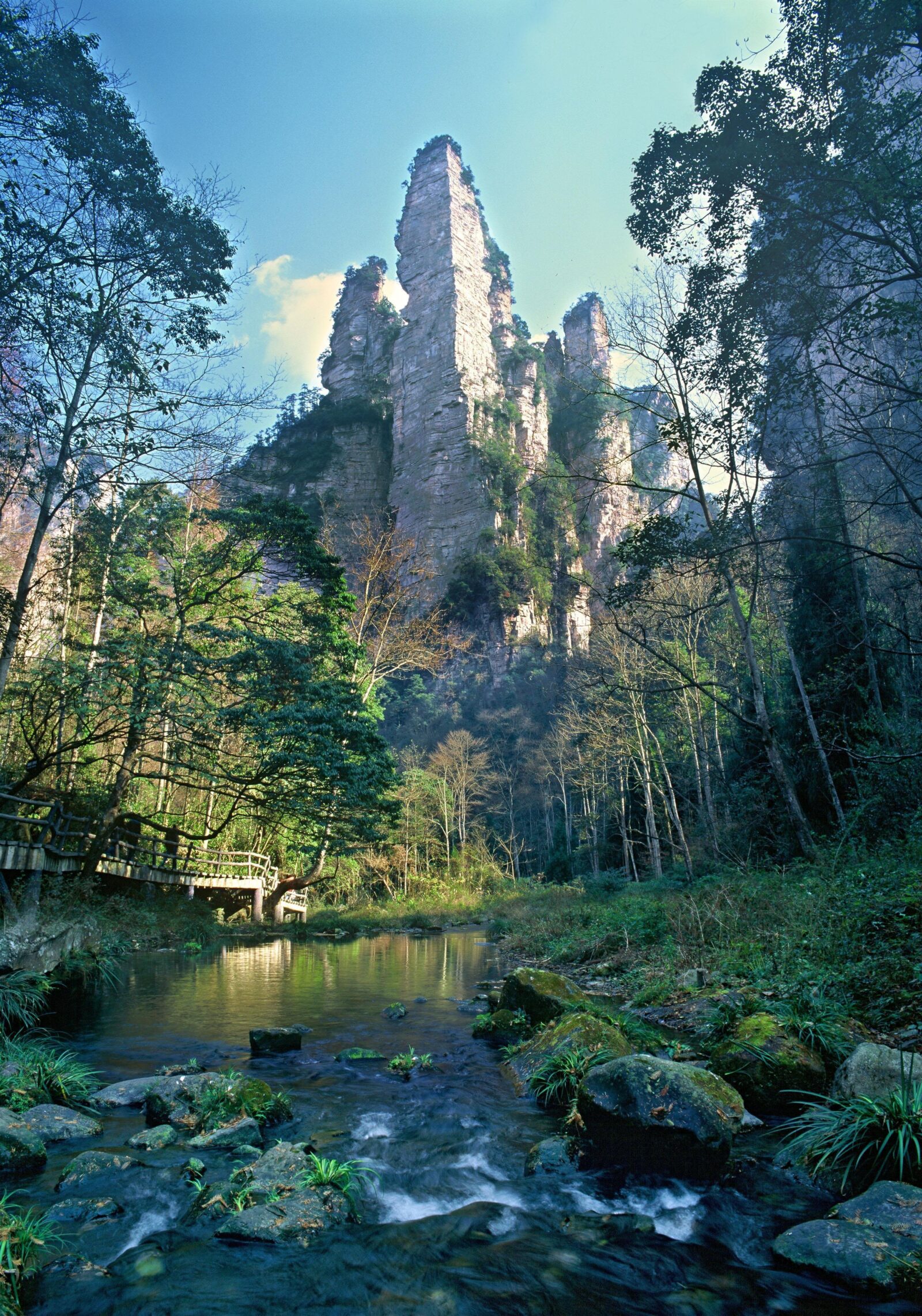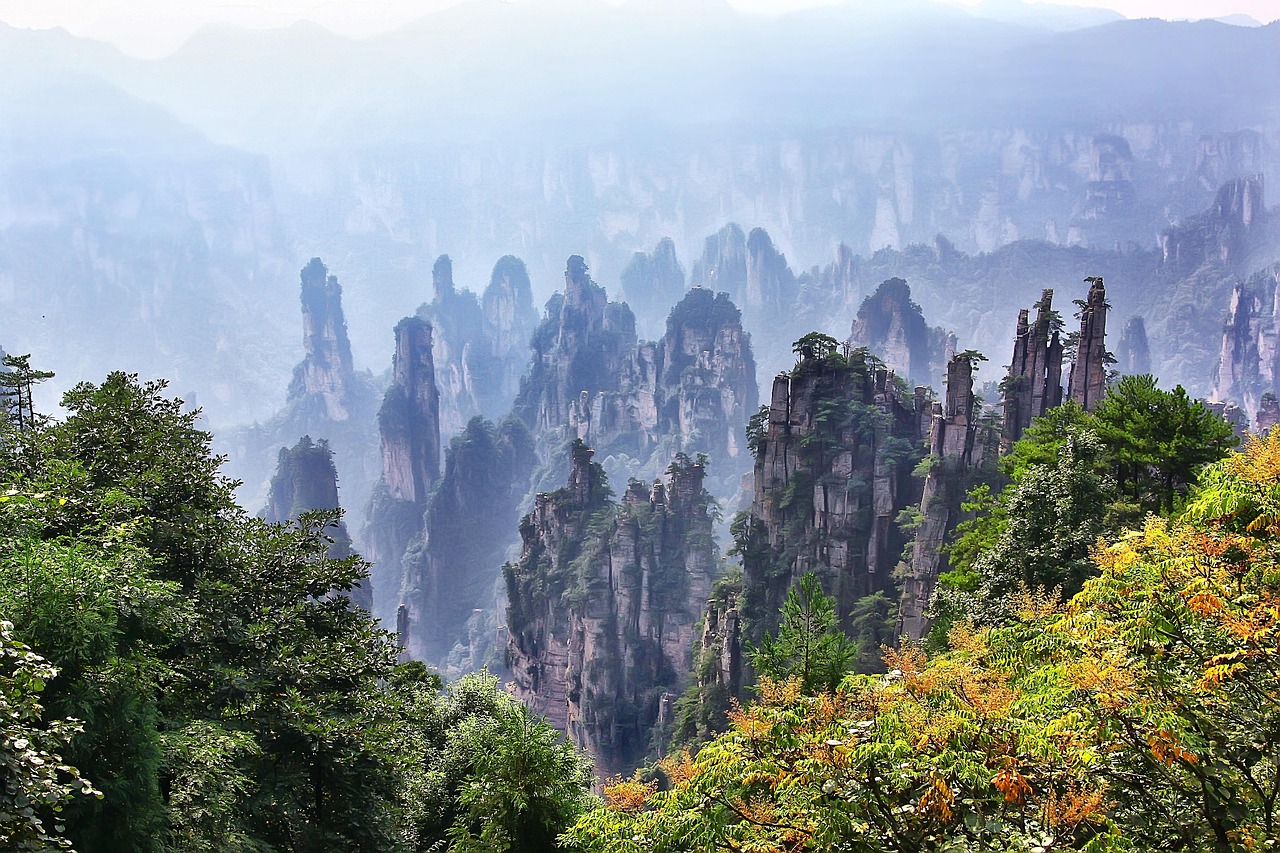I thought the floating mountains in Avatar were pure CGI—until I stood in Zhangjiajie. That first morning at Yuanjiajie, with clouds curling around the stone peaks, I just froze. It looked too surreal to be real. And yet, there it was: the scene that inspired Pandora, rising in silence.But I came at the wrong time. The fog stayed. The crowds too. I waited hours just to get a glimpse through the haze. That trip was a mix of awe and frustration. I didn’t know that the best time to visit Zhangjiajie isn’t just “any time it’s open.” The seasons matter. So does light, air, and how long you're willing to wait.I’ve come back twice since then. Once in October, once in April. Different skies, different pace. I stopped chasing the perfect view and started listening to the mountain instead. This isn’t a list. It’s what I learned from showing up too early, too late—and once, just right.
Planning your trip? Here’s a Zhangjiajie itinerary with routes and tips to keep things simple.
When Is the Best Time to Visit Zhangjiajie?
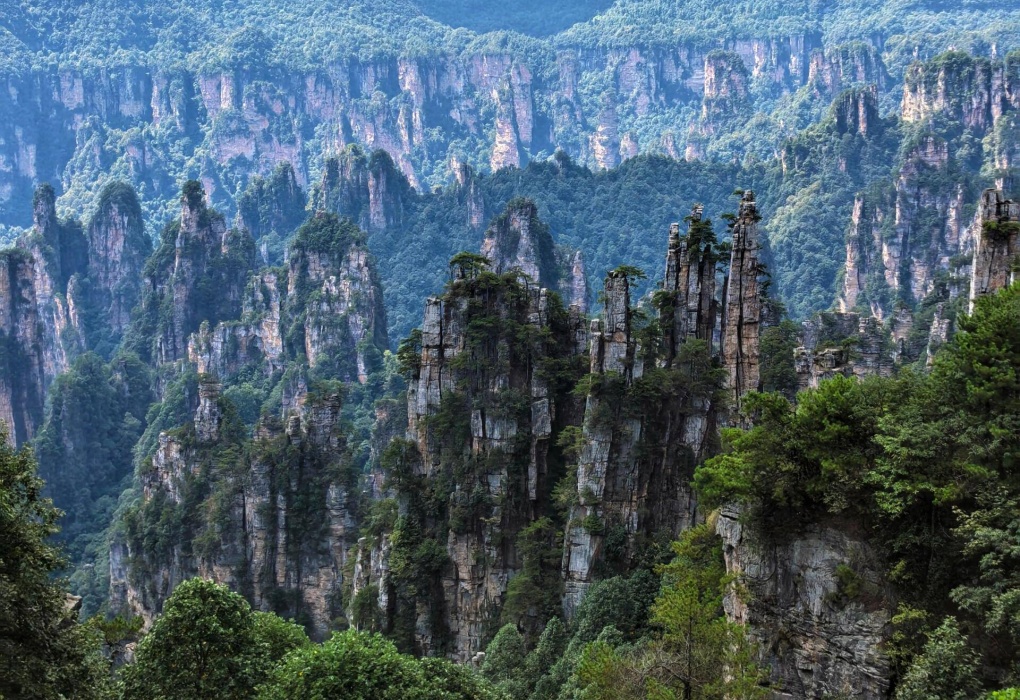
When Is the Best Time to Visit Zhangjiajie?
My Favorite Months: Why April and October Always Win
People ask me when to go. I always say April or October. No thinking, just that. I’ve been three times, and those months made sense. April had cool air and quiet trails. Mist clung to the cliffs, but not enough to block them. It felt calm, like the mountain was half-asleep but still watching you.October was brighter. Fewer people, sharper views. Gold leaves everywhere. I remember standing alone at Yuanjiajie, thinking, this is what those old Chinese paintings were trying to show. That moment stuck. So if you want the best time to visit Zhangjiajie, pick the seasons when the mountain opens up—and doesn’t mind being seen.
he temperatures during these two seasons stay between 15–25°C (59–77°F), which makes hiking super comfortable. You’ll still catch some fog, especially early mornings around Tianzi Mountain. And that fog? It's what gives Zhangjiajie its nickname “Avatar Mountains.” The stone pillars fade in and out of view like they’re floating islands. October’s dry and sunny—ideal for catching those epic views from the Bailong Elevator or the Glass Bridge without worrying about slippery paths.
These two months also avoid China's major holidays. I learned quickly that timing your trip around Chinese crowds is half the battle. In April and October, most schools are in session and domestic tourism dips. You’ll have a much smoother ride on local transport, and hotel prices stay reasonable. From a photographer’s view and a traveler’s budget, it’s the sweet spot. In short: if you're choosing the right time to visit Zhangjiajie, aim for spring or fall. You’ll thank yourself.
- Average Temp in April: 15–25°C
- Average Temp in October: 12–22°C
- Fog Density (Visual Rating): Medium to High (April), Low to Medium (October)
- Crowd Level: Moderate
- Best Trails: Golden Whip Stream (April), Tianzi Mountain (October)
Summer vs. Winter: Should You Avoid the Extremes?
The first time I checked flights for Zhangjiajie, it was mid-July. I didn’t think much about weather—I just had time off. But then I started reading. Words like “humid,” “slippery,” “fogged out.” One guy said he climbed two hours and saw nothing but white. I looked at photos: staircases disappearing into mist, people wiping sweat with park maps. Something in me said, maybe not. Summer felt too loud, too heavy. Like the mountains were there, but didn’t want to show themselves.
Winter crossed my mind later. Snow on the peaks sounded quiet and kind of unreal. I pictured empty trails and blue air. But every traveler I asked said the same thing: closed cable cars, icy steps, long waits for buses. No, thank you. I don’t want to squint through frost to guess where the peaks are. So no, I’ve never done summer or winter. Maybe one day, if I know what I’m in for. But until then, the best time to visit Zhangjiajie—for me—is still spring or fall, when the views are clear and the mountains don’t play hard to get.
| Season | Avg. Temp | Weather Notes | Recommendation |
|---|---|---|---|
| Summer | 28–35°C | Humid, rainy | For flexible travelers |
| Winter | -2–10°C | Limited access, fewer tourists | For seasoned hikers |
What About Chinese Holidays? The Crowds Will Surprise You
My first trip to Zhangjiajie was during Golden Week in October. Big mistake. I didn’t know much about Chinese holidays at the time, but now I do. During national holidays like May 1st Labor Day and October 1st National Day, the crowds are wild. I’m talking about 2-hour lines just to get into the park, and hotel prices doubling or tripling.
It wasn’t just about waiting. The whole vibe changes. Tranquil forests become noisy walkways. Even local restaurants get overwhelmed, and trains into Zhangjiajie get booked weeks in advance. That trip taught me a core rule: the best time to visit Zhangjiajie is when China isn’t on vacation.
Since then, I’ve planned all my return trips around the Chinese school calendar. If you check dates and avoid peak travel times, you’ll get better service, better views, and way fewer headaches. Most popular hotels—even the ones foreign tourists love, like Pullman Zhangjiajie—are much more available and sometimes offer discounts off-season. And yes, they do accept foreigners and often have English-speaking staff.
- Avoid These Dates: May 1–5, October 1–7, Chinese New Year
- Hotel Prices Spike: Up to 300% increase during holidays
- Pro Tip: Check Chinese calendar + book trains on 12306 China Railway app
What Makes Zhangjiajie Worth Visiting in Different Seasons?
- Spring
- Autumn
- Winter
Springtime Magic: Misty Peaks and Fresh Trails
Spring in Zhangjiajie feels like stepping into a dream. The first time I visited in April, I honestly didn’t expect it to be so surreal. The air was fresh, trails were lined with blooming wildflowers, and the mist wrapped around the peaks like something out of a fantasy novel. If you’re chasing that iconic “Avatar mountain” look, spring is the best time to visit Zhangjiajie.
What makes spring really special is the balance. You get good weather, but not the kind that brings massive crowds. In April and early May, most domestic tourists are still working or studying. That means more quiet moments for you on popular routes like Golden Whip Stream or the hike to Yuanjiajie. And the fog? It's not annoying—it's atmospheric. It rolls in gently during the morning, then clears up by noon, giving you two moods in one hike.
Zhangjiajie in spring also offers great photo lighting. I brought my drone on one trip and got shots that felt like traditional Chinese ink paintings—soft grays, layered peaks, birds gliding between stone towers. This kind of magic is hard to find elsewhere. Honestly, if you're deciding the right season to visit Zhangjiajie, don’t overthink it. Spring hits the sweet spot. Comfortable weather, cinematic views, and lighter crowds—it’s hard to beat.
- Best Months: April to early May
- Average Temperature: 15–25°C
- Trails Recommended: Golden Whip Stream, Ten-Mile Gallery
- Fog Intensity: Medium (clears by midday)
- Gear Tips: Bring a light windbreaker and waterproof shoes
Autumn Colors You Won’t Forget
October in Zhangjiajie is something I keep going back for. The colors, the skies, the peace—it’s a combination that’s tough to beat. I came here once in early October (right after the holiday crowds left), and the forests were glowing in reds, oranges, and yellows. It reminded me of fall foliage in Vermont, but here the colors surround vertical cliffs instead of rolling hills. If you want your trip to feel magical and relaxed, autumn is the best time to visit Zhangjiajie.
One underrated perk of October is visibility. Unlike spring, which brings mist, autumn gives you crystal-clear views. You can see every peak from the Yuanjiajie platform, and the photos barely need filters. I’ve never seen such perfect conditions for landscape photography. The sunrise from Tianzi Mountain? Still the best one I’ve ever seen in China.
The temperatures in fall are just right—neither sweaty nor freezing. You’ll walk comfortably all day, and evenings are cool enough for a light jacket. Crowds start to thin out after the first week of October. That’s when prices drop, trails calm down, and the real charm of the mountains kicks in. So if you’re wondering the right month to visit Zhangjiajie without stress, October is your golden window.
- Best Time: October 8–31
- Average Temp: 12–22°C
- Highlights: Autumn leaves, sunrise at Tianzi Mountain
- Ideal Crowd Level: Low to Moderate
- Tip: Use Ctrip.com for off-season hotel discounts
The Offbeat Winter Charm: Is It Worth It?
I haven’t been to Zhangjiajie in deep winter, but I almost did—and I’ve spoken to friends who swear by the winter vibe. If you’re the type who prefers solitude over sightseeing, January might actually be the best time to visit Zhangjiajie for you. The landscape changes completely. Think frosted trees, quiet trails, and zero crowds. There’s something eerie but peaceful about seeing the stone peaks capped with snow.
But winter comes with trade-offs. Some paths are closed for safety, especially during snow or ice. Cable cars like Tianzi Mountain Ropeway may pause for maintenance. If you’re hoping to hit all the classic sights, this season might let you down. That said, if you’ve already visited once and want something different, it’s a unique way to see the park.
A bonus? Prices drop significantly. Hotels go on heavy discount, and flights are easier to book. I checked rates in January and found top-rated hotels like Zhangjiajie Pullman for under 500 RMB per night—yes, they accept foreigners. Just bundle up and bring non-slip shoes. For quiet seekers and repeat visitors, this might just be Zhangjiajie’s best-kept secret.
| Month | Avg. Temp | Hotel Price Range | Crowds | Notes |
|---|---|---|---|---|
| January | -2–10°C | 300–500 RMB | Very low | Trails partly closed |
Things I Got Wrong on My First Zhangjiajie Trip
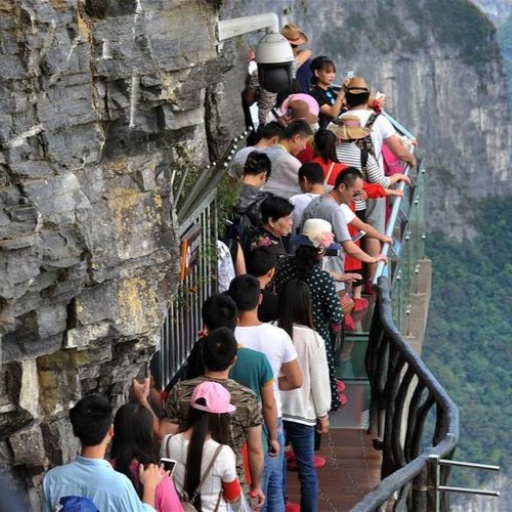
The crowded tourist scene in Zhangjiajie
Booking Too Late During Peak Season
The first time I visited Zhangjiajie, I thought I could just book everything when I arrived. Bad move. I landed during late April—arguably the best time to visit Zhangjiajie—and all the good hotels near the park were gone. I had to stay in the city center, which meant a 90-minute ride each way to the scenic area. That ate up my mornings and drained my energy after hiking.
Now I always book at least three weeks ahead, especially in April and October. Wulingyuan has great hotels that accept foreigners, like Pullman Zhangjiajie and Pipaxi Hotel. They’re close to the entrance, offer English service, and often have deals on Ctrip. If you’re visiting during the peak Zhangjiajie travel season, don’t wing it—plan ahead and stay close.
Trusting Weather Forecasts Too Much
Before my second trip, I checked five weather apps. They all said sunny. I got fog. Thick, mountain-hiding fog. I had one day planned at Tianzi Mountain and couldn’t see a thing. That’s when I learned: even in the best time to visit Zhangjiajie, forecasts lie. Mountain weather changes fast, and one hour can flip from clear to cloudy.
Now I always stay at least four days when I go. That way, if one day is a bust, I can wait it out. Especially in spring and fall—peak times but also the most unstable weather. If you’re planning for the perfect Zhangjiajie trip, buffer days are a must.
What Makes Zhangjiajie Special Besides the Weather?
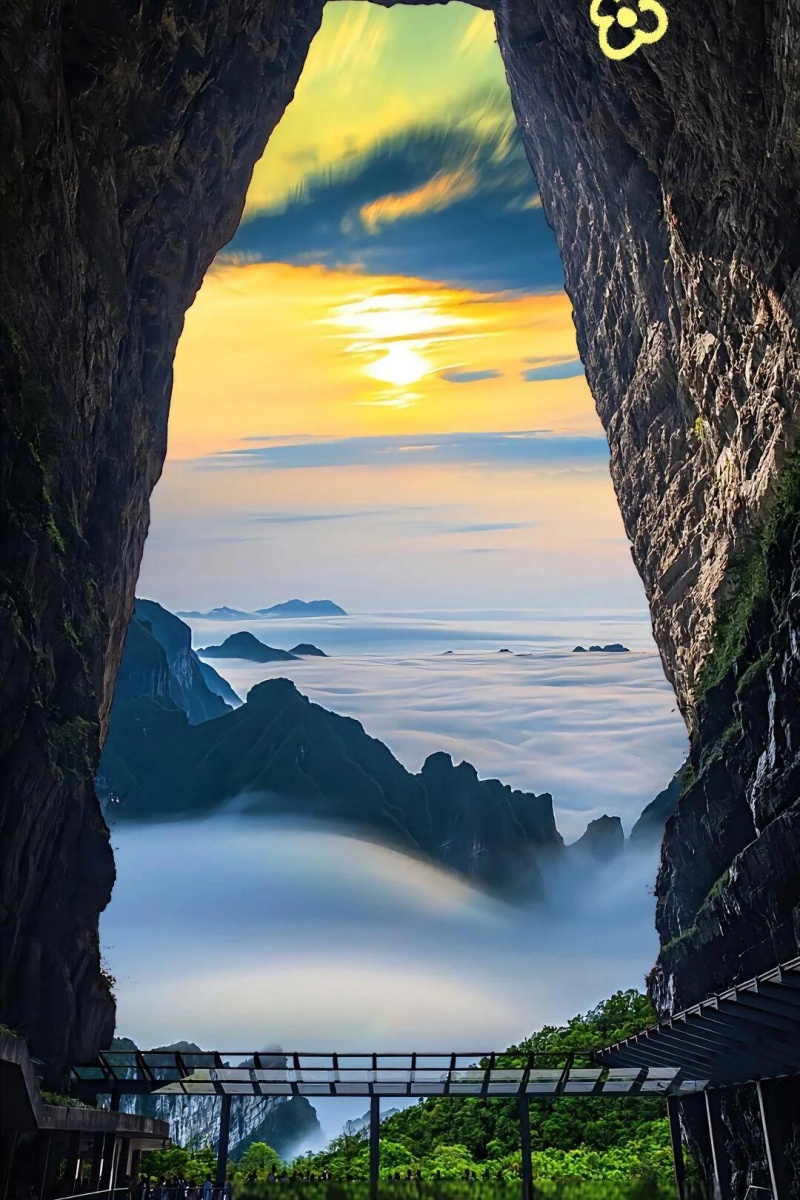
Zhangjiajie's morning
Mountain Views That Change Every Hour
Zhangjiajie isn’t just a place—it’s a mood that shifts with the sky. One reason people say spring and autumn are the best times to visit Zhangjiajie is because of how dramatic the light and fog can be. I’ve stood on the same viewing platform in the morning and again in the afternoon, and it felt like two different places. The way the sun cuts through the haze, or how fog suddenly wraps a peak—it's mesmerizing.
What makes this place extra special is the constant transformation. I once spent an entire afternoon at Yuanjiajie, just watching the landscape change every 20 minutes. No photo could capture it. That’s why I tell people the ideal time to visit Zhangjiajie isn’t just about weather—it’s also about giving yourself time. These mountains breathe. If you rush through, you’ll miss that part of their magic.
And even if you’ve seen “Avatar,” nothing prepares you for how the real rocks glow in late sunlight. The floating-mountain look is more intense in person. Locals told me that’s why early morning and late afternoon light is called “仙光” (fairy light). If you’re visiting in April or October, stay on the trails longer—you’ll see the landscape change before your eyes. For scenery that doesn’t sit still, this is the best time to visit Zhangjiajie.
- Photo Pro Tip: Visit viewpoints twice a day
- Best Times for Light: 8–9am & 4–5:30pm
- Great Spots: Yuanjiajie, Tianzi Mountain, Avatar Hallelujah Platform
Cultural Gems Hidden Around the Forest
Everyone talks about Zhangjiajie’s peaks, but no one warned me about the culture I’d stumble into—and I mean that in a good way. Between the famous hikes, I found time to visit small Tujia villages and watch live performances that showed just how alive this place really is. During my October visit—the best time to visit Zhangjiajie if you want nice weather and local events—I caught a Tujia drum dance in the square. Raw, loud, totally unforgettable.
What makes Zhangjiajie special is how its culture blends into nature. I visited a stilted wooden house built along the riverbank and shared smoked pork with a host who barely spoke English but smiled like an old friend. It reminded me of visits to rural Japan—quiet, respectful, deeply rooted in place. The weather in fall makes these detours easy. You’re not rushing through heat or trapped by rain. That’s why autumn is an ideal time to visit Zhangjiajie, especially if you’re curious about more than just rocks.
Even food carries the local spirit. Try sour fish soup, Tujia bacon, and sticky rice cakes made fresh from mountain ingredients. Many small eateries accept mobile payments and are used to tourists. In peak seasons, some even offer bilingual menus. So while spring and fall bring better hiking weather, they also unlock Zhangjiajie’s cultural layers. That’s what makes them the best seasons to visit Zhangjiajie—hands down.
What Else Should You Know Before Planning a Zhangjiajie Trip?
- Folk events in Wulingyuan town
- boiled tofu
Key Packing Tips by Season
Packing for Zhangjiajie depends heavily on when you’re visiting. Since the best time to visit Zhangjiajie is spring and fall, you’ll want light, layered clothing. In April, mornings are cool but afternoons can get warm. I usually bring a thin hoodie, a packable windbreaker, and lightweight hiking pants. If you’re coming in October, a fleece and rain shell will cover most situations. Don’t forget a small towel or sweatband—even in cooler months, hikes here are serious cardio.
Shoes matter more than you think. Most trails are stone or dirt, and when it rains, they get slippery fast. A sturdy pair of hiking shoes with decent grip will save your knees. I've seen people attempt Yuanjiajie in sneakers and regret every step. Spring showers are common, so pack a waterproof bag cover and quick-dry socks. Even in the best Zhangjiajie seasons, the weather loves to shift on you.
One overlooked item? Cash. While most places accept mobile payments, some village shops still prefer paper bills. Also, bring a translation app—though most major hotels have English-speaking staff during peak travel months, signage in smaller spots may be Chinese-only. And bring a power bank! Some hikes go 5–6 hours and you’ll drain your phone fast taking pictures of those best views in Zhangjiajie.
| Season | Essentials |
|---|---|
| Spring | Windbreaker, quick-dry layers, rain cover |
| Fall | Fleece, gloves (late Oct), backup charger |
Best Local Foods by Season
One of the reasons spring and autumn are often called the best times to visit Zhangjiajie is because that’s when local food shines. In spring, everything feels fresh—from the air to the plates. Try mountain-grown wild vegetables stir-fried with garlic, and tofu boiled in mineral-rich spring water. These dishes are mild but rich in texture, perfect after a long hike. You’ll also find fresh bamboo shoots and cold mung bean noodles topped with sesame oil—a popular lunch option among local guides.
Summer meals, on the other hand, are all about cooling down. Zhangjiajie gets humid in July, so locals lean into dishes that refresh the body. Sour fish soup, served cold or lukewarm, cuts through the heat. Chilled tofu with preserved chili and vinegar is another local hit. After hiking under the sun, these meals feel like instant air-con. Summer isn’t the ideal time to visit Zhangjiajie weather-wise, but the food helps. Look for small eateries near Baofeng Lake—they often cater to both locals and tourists.
Then comes autumn and winter, when flavors get deeper. October brings smoked pork, sticky rice in bamboo tubes, and wood-fired hotpots with wild mushrooms. It’s the season when food becomes comfort. If you're visiting in winter, expect hearty bowls of stewed chicken with mountain herbs and glutinous rice dumplings. Street stalls near Wulingyuan town offer spicy roasted sweet potatoes—a perfect hand-warmer and snack. For many visitors, this cozy culinary vibe is why fall and winter rank among the best Zhangjiajie travel seasons.
| Season | Must-Try Dishes |
|---|---|
| Spring | Wild greens, boiled tofu, bamboo shoots |
| Summer | Sour fish soup, vinegar tofu, iced noodles |
| Autumn | Smoked pork rice, mushroom hotpot, sticky rice |
| Winter | Herb chicken stew, roasted sweet potatoes, dumplings |
Frequently Asked Questions (FAQs)
Q: When is the least crowded time to visit Zhangjiajie?
Try mid-April or late October. Tourist numbers drop after holidays. Avoid May Day and National Day week. Those dates bring in heavy domestic travel. In quieter weeks, trails feel calmer and more personal. You won’t wait in cable car lines forever. Hotels drop prices too, especially on weekdays. Mornings are peaceful and air is fresh. You’ll still catch great mountain views. That’s the best time to visit Zhangjiajie without tourist overload. Just check school calendars before booking flights.
Q: What’s the best way to avoid crowds at top attractions?
Start early—before 7am if you can. Most tour groups arrive mid-morning. You’ll get clear paths and cleaner views. Use side entrances when possible. Zhangjiajie National Forest Park has multiple gates. Take less popular trails like Yangjiajie or the old steps up Tianzi. Those offer quieter experiences with just as much beauty. Avoid public holidays if your schedule allows it. Weekdays are much better than weekends. And stay overnight near the park to get a head start.
Q: Do I need to book tickets in advance for Zhangjiajie?
Yes, especially during the best time to visit Zhangjiajie. Spring and fall are very popular. During holidays, tickets can sell out fast. Forest Park tickets and cable cars often have daily limits. Use Ctrip or WeChat mini programs to book online. Booking ahead also lets you choose entry times. That saves waiting and stress later. Some hotels can help with local bookings too. Don’t risk arriving without a plan—you’ll waste your first day sorting tickets.
Q: What should I wear when visiting Zhangjiajie in October?
Layers are your best friend in October. Mornings can get chilly fast. Afternoons feel warm under direct sun. Bring a light fleece and windbreaker. Good hiking shoes are essential for slippery stone paths. Pack a hat and sunglasses too. Trails are long, so comfort matters. October weather is kind, but unpredictable. A compact umbrella won’t hurt. Nights cool down quickly near the forest. Stay dry and warm, especially if you hike early. October is a great month to visit.
Q: Is Zhangjiajie suitable for older travelers or kids?
Yes, but plan smart. Some trails are steep and long. Use cable cars whenever possible. They save time and knees. The best time to visit Zhangjiajie with family is in cool months. Spring and autumn make walking easier. Avoid peak heat in summer. And skip icy winter trails for safety. Many viewing platforms are flat and well-paved. Stay close to town if mobility is a concern. Local guesthouses often offer custom tour help. Keep it relaxed and paced.
Q: Can I visit Zhangjiajie without speaking Chinese?
Absolutely, especially during the busy seasons. Most big hotels have English-speaking staff. Signs at main attractions include English translations. Use translation apps for taxis or restaurants. Staff in scenic areas are used to foreign tourists. During the best time to visit Zhangjiajie, locals expect international visitors. It helps to learn a few phrases though. Apps like Pleco work offline. Booking platforms like Ctrip support English. Just avoid remote mountain villages if language is a worry.
Want more China travel ideas? Check out our city guides on Beijing, Shanghai, Guangzhou, and Chengdu.
